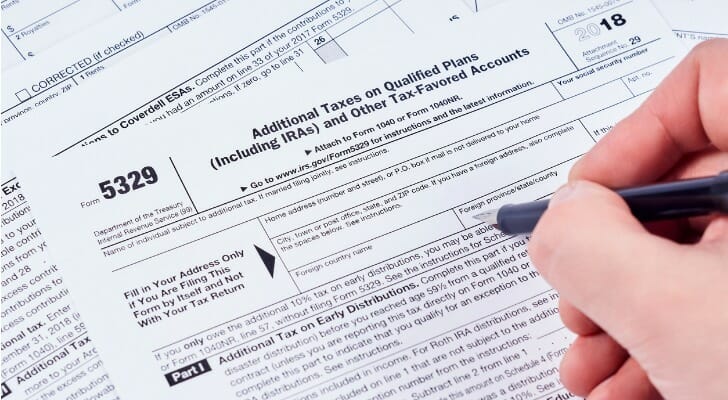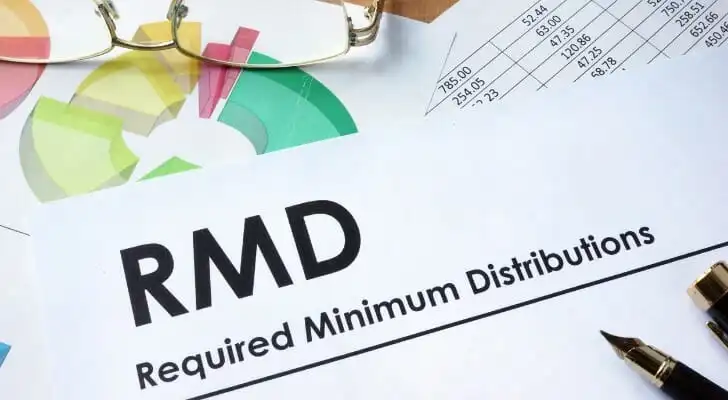When you miss the deadline for taking a required minimum distribution (RMD) for your retirement account, you generally have two options: pay a substantial fine or apply for a waiver. Either way, there is quite a bit of paperwork to fill out, and of course, you will have to fix your mistake and still take the required distributions. This guide provides an overview of RMDs, the taxes surrounding them and the form you need if you miss your RMD deadline, IRS Form 5329.
If you need help planning your retirement income, consider talking to a financial advisor.
Required Minimum Distributions (RMDs)
When you put money into an individual retirement account (IRA) or any other tax-deferred retirement account, you can’t leave it there forever.
Since January 1, 2023, you must take a required minimum distribution or withdrawal from your plan beginning at age 73. Similar to most other forms of income, you must pay income taxes on these distributions.If you fail to take an RMD on time and for the right amount, the penalty can be severe. For every dollar you did not withdraw in time,, the IRS charges a 25% penalty tax. While this can add up significantly over time, the penalty drops to 10% if you correct your mistake within two years.
The IRS determines the RMD amount by dividing the total balance of all of your IRA accounts by a distribution figure that corresponds with your age.
For example, at age 73, the IRS divides your age by 26.5. If you have $100,000 across one or more IRAs, your RMD is calculated by dividing $100,000 divided by 26.5. As a result, you’re required to withdraw around $3,773. Forgetting to take your RMD entirely could leave you liable for 25% of that amount, or about $943 in penalty taxes.
Adding to the problem, the rules for when you have to take your RMD are somewhat complicated, and neither the IRS nor your retirement plan provider is required to notify you of the specifics surrounding your RMD. This is where working with a financial advisor can be extremely valuable.
Missed RMD: Penalty Waivers and Form 5329

First things first – Whether you miss your RMD or don’t make the appropriate withdrawal, it is important to address the issue immediately. Be sure to calculate your RMD accurately this time around, working with a retirement advisor if needed.
Next, you need to file IRS Form 5329. If you want to just pay the 25% penalty tax, this is the form to use when sending in your check.
However, don’t jump to make that payment because the IRS will waive the penalty if there is a reasonable error. While there are no guarantees, many taxpayers are able to get the waiver.
Requesting a waiver is as simple as sending a letter of explanation with Form 5329. In your letter, give a clear overview of why you think you qualify for a waiver. It is also wise to include a description of the steps you have taken to remedy this issue.
If you take this route, do not send a payment with your letter. It is very possible that you may receive the waiver and no payment will be due.
Unfortunately, there’s no defined rule describing what the IRS considers a reasonable error. However, some circumstances that often result in a waiver include an illness, a death in the family, a natural disaster, a move that disrupted your mail or even bad tax advice.
If you believe you have experienced an event that may qualify as a reasonable error, follow the aforementioned process. The IRS will let you know if it chooses to approve your waiver request.
Required Minimum Distribution Timeline
For those 73 or older, the RMD withdrawal deadline is April 1 of the following calendar year. For every year after this, the deadline shifts to December 31.
If you choose to delay your withdrawal until April 1, you will need to withdraw two RMDs the first year after turning 73. The initial deadline is April 1, and the second withdrawal must be made by December 31.
There is one important caveat. Those born in 1960 or later do not have to take RMDs until age 75.
For some taxpayers, it may be advisable to take the first RMD, normally be due in April, on or before December 31 of the previous year. This could help you lower your taxable income so you do not fall in a higher tax bracket.
Another RMD mistake that people sometimes make is taking their RMD from the wrong account. The IRS requires RMDs from many different types of retirement accounts, including:
You can take your RMD from any one or combination of your own retirement accounts. However, withdrawals from spousal accounts do not qualify toward your RMD requirement.
When you inherit a retirement account, the RMD rules change again. If the original account owner died before age 73, then the beneficiary must begin RMD withdrawals. Those RMDs must start by December 31 of the year following the original account owner’s death.
Make sure you’re taking the right amount by starting your own RMD calculation:
Required Minimum Distribution (RMD) Calculator
Estimate your next RMD using your age, balance and expected returns.
RMD Amount for IRA(s)
RMD Amount for 401(k) #1
RMD Amount for 401(k) #2
About This Calculator
This calculator estimates RMDs by dividing the user's prior year's Dec. 31 account balance by the IRS Distribution Period based on their age. Users can enter their birth year, prior-year balances and an expected annual return to estimate the timing and amount of future RMDs.
For IRAs (excluding Roth IRAs), users may combine balances and take the total RMD from one or more accounts. For 401(k)s and similar workplace plans*, RMDs must be calculated and taken separately from each account, so balances should be entered individually.
*The IRS allows those with multiple 403(b) accounts to aggregate their balances and split their RMDs across these accounts.
Assumptions
This calculator assumes users have an RMD age of either 73 or 75. Users born between 1951 and 1959 are required to take their first RMD by April 1 of the year following their 73rd birthday. Users born in 1960 and later must take their first RMD by April 1 of the year following their 75th birthday.
This calculator uses the IRS Uniform Lifetime Table to estimate RMDs. This table generally applies to account owners age 73 or older whose spouse is either less than 10 years younger or not their sole primary beneficiary.
However, if a user's spouse is more than 10 years younger and is their sole primary beneficiary, the IRS Joint and Last Survivor Expectancy Table must be used instead. Likewise, if the user is the beneficiary of an inherited IRA or retirement account, RMDs must be calculated using the IRS Single Life Expectancy Table. In these cases, users will need to calculate their RMD manually or consult a finance professional.
For users already required to take an RMD for the current year, the calculator uses their account balance as of December 31 of the previous year to compute the RMD. For users who haven't yet reached RMD age, the calculator applies their expected annual rate of return to that same prior-year-end balance to project future balances, which are then used to estimate RMDs.
This RMD calculator uses the IRS Uniform Lifetime Table, but certain users may need to use a different IRS table depending on their beneficiary designation or marital status. It's the user's responsibility to confirm which table applies to their situation, and tables may be subject to change.
Actual results may vary based on individual circumstances, future account performance and changes in tax laws or IRS regulations. Estimates provided by this calculator do not guarantee future distribution amounts or account balances. Past performance is not indicative of future results.
SmartAsset.com does not provide legal, tax, accounting or financial advice (except for referring users to third-party advisers registered or chartered as fiduciaries ("Adviser(s)") with a regulatory body in the United States). Articles, opinions and tools are for general informational purposes only and are not intended to provide specific advice or recommendations for any individual. Users should consult their accountant, tax advisor or legal professional to address their particular situation.
Special RMD Rules and Common Exceptions
Not all retirement accounts follow the same RMD rules, and certain situations can change when withdrawals are required.
One common exception applies to employer-sponsored plans, such as 401(k)s and 403(b)s. If you are still working for the employer sponsoring the plan and you are not a 5% owner, you may delay RMDs from that specific plan until you retire. However, this exception does not apply to IRAs, nor does it apply to any plans from former employers, which must still follow the standard RMD timeline beginning at age 73.
Roth IRAs also operate under a different set of rules. Unlike traditional IRAs, Roth IRAs do not require RMDs during the owner’s lifetime.
Roth 401(k)s and Roth 403(b)s did require RMDs in the past, but beginning in 2024, RMDs for Roth employer plans are eliminated under current IRS regulations. Beneficiaries who inherit these accounts may still be subject to RMD rules, depending on their relationship to the original account holder.
Rollovers add another wrinkle. If you complete a rollover late in the year, the RMD for the distributing account must still be taken before the rollover occurs. RMD amounts cannot be rolled over, and failing to withdraw the correct amount before moving funds can lead to penalties. This is especially important when consolidating multiple accounts or moving funds between custodians.
Younger beneficiaries have their own set of rules under the SECURE Act’s 10-year distribution rule. Depending on their classification (eligible designated beneficiary, minor child, disabled individual or non-spouse beneficiary), the required withdrawal schedule may differ.
Bottom Line

If you find yourself dealing with an RMD penalty, don’t feel alone. RMDs can be tough to understand. You may be able to minimize the 25% tax if you make a mistake. However, the best way to avoid these complications entirely is to make your payments on time and in full. Don’t be afraid to ask questions or even speak to a financial advisor if you’re uneasy and nearing your deadline.
Tips for Managing Your Retirement Savings
- TA financial advisor can help you save and plan for retirement. Finding a financial advisor doesn’t have to be hard. SmartAsset’s free tool matches you with vetted financial advisors who serve your area, and you can have a free introductory call with your advisor matches to decide which one you feel is right for you. If you’re ready to find an advisor who can help you achieve your financial goals, get started now.
- Responsibly managing your retirement funds can be difficult, but there are tools available to help you plan things out. SmartAsset’s retirement calculator takes the details of your personal financial situation and assesses how much you’ll need to retire securely. To be as precise as possible, make sure you know where you want to retire, your current annual income, the age you expect to take Social Security and how much you’re currently saving every month.
Photo credit: ©iStock.com/designer491, ©iStock.com/MaksimShchur,©iStock.com/designer491
